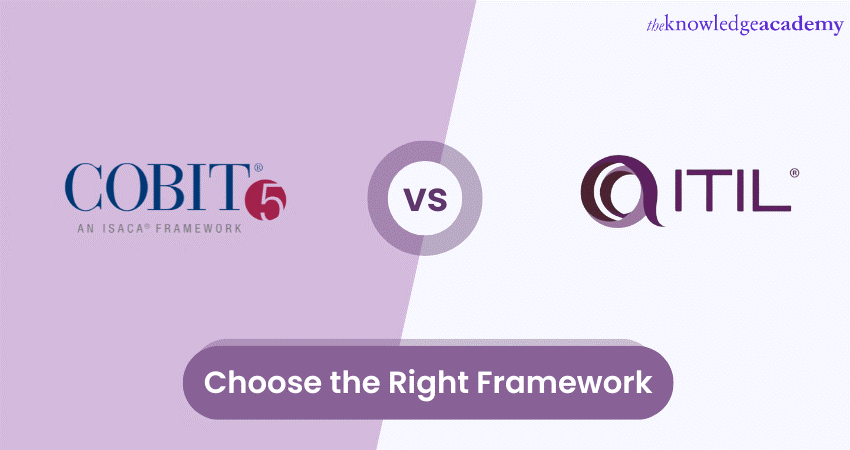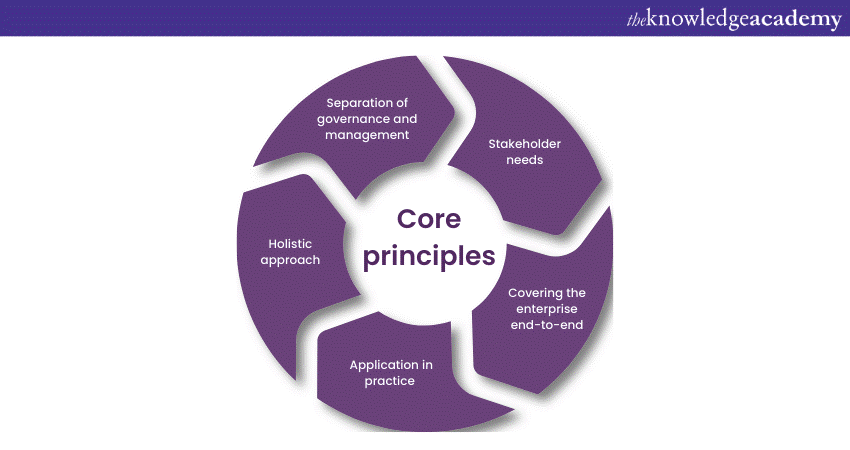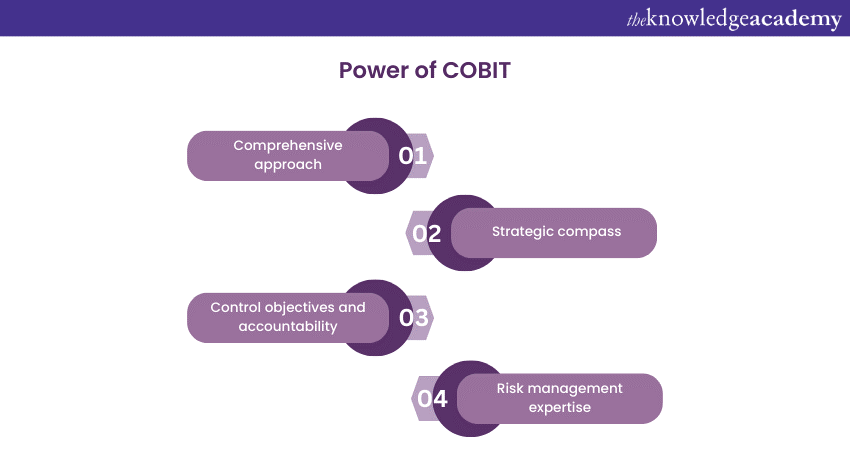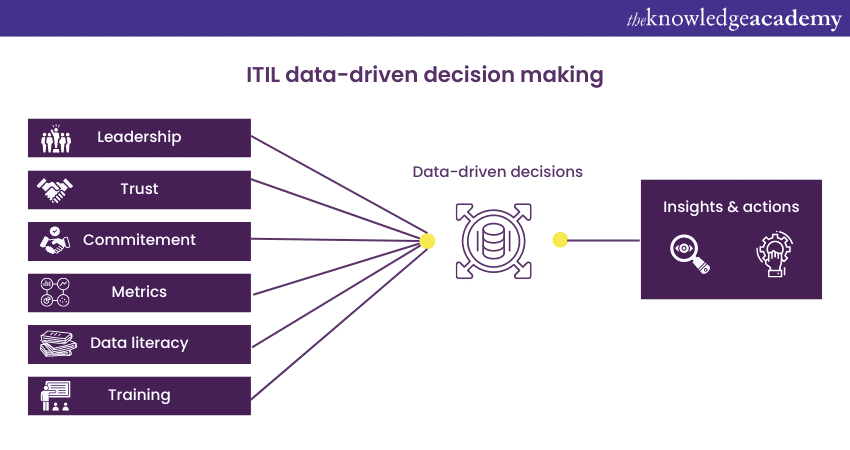We may not have the course you’re looking for. If you enquire or give us a call on +61 272026926 and speak to our training experts, we may still be able to help with your training requirements.
Training Outcomes Within Your Budget!
We ensure quality, budget-alignment, and timely delivery by our expert instructors.

When it comes to managing IT processes and governance, two prominent frameworks are often debated: COBIT vs ITIL. Both frameworks serve as comprehensive standards to help organisations optimise their IT management practices. However, they have distinct characteristics that make them suitable for different scenarios.
Therefore, understanding COBIT vs ITIL is important because misapplying frameworks can lead to inefficiencies. COBIT focuses on wholesome governance, aligning IT with business objectives. ITIL, on the other hand, emphasises Service Management and delivery. Knowing these distinctions helps organisations choose the framework that aligns with their strategic goals.
So, if you wish to implement any of these frameworks and optimise your organisation’s IT Governance, it is crucial to understand their differences. Explore the intricate differences between COBIT vs ITIL frameworks in our comprehensive blog. Uncover the strengths, weaknesses, and practical applications of each.
Table of Contents
1) What is COBIT?
2) What is ITIL?
3) Contrasting COBIT vs ITIL
4) The power of COBIT
5) The essence of ITIL's strength
6) Deciding your path between COBIT and ITIL
7) Conclusion
What is COBIT?
Control Objectives for Information and Related Technologies (COBIT) is a brainchild of the Information Systems Audit and Control Association (ISACA), a global association. Initially, COBIT targeted auditors. Its purpose was to manage IT risks. Now, it has a broader vision. It serves organisations of all sizes. Its focus: holistic IT Governance. At COBIT's core lie five principles that are as follows:

a) It prioritises stakeholders, ensuring that IT aligns with business objectives.
b) COBIT integrates all business functions, not just IT.
c) It’s not just theoretical; COBIT offers actionable guidance.
d) It examines governance from varied angles, including processes, structures, and information sources.
e) COBIT distinguishes governance and management by providing clarity on roles.
Key features
Organisations harness COBIT for various reasons:
a) Alignment: Melding business goals with IT actions to optimise returns.
b) Compliance: For industries burdened with regulations, COBIT is a lifeline. It ensures IT processes comply, minimising risks.
c) Trust building: With COBIT, organisations can ensure data integrity and security.
COBIT’s structure is intricate. It is divided into domains like planning and monitoring, providing direction. Within these domains, specific processes steer the way forward.
What is ITIL?
ITIL, or the Information Technology Infrastructure Library, has British origins. It started as the UK government's answer to standardise IT practices. In the 1980s, ITIL was born with an aim for a consistent IT Service Management approach. Over decades, ITIL's influence spread worldwide. Today, it's a leading IT Service Management framework. ITIL thrives on a lifecycle approach that offers the following benefits:
a) Service strategy: It includes envisioning, planning and prioritising IT services align with this strategy.
b) Service design: Here, services get shaped. It ensures they meet business needs.
c) Service transition: It focuses on change. New or changed services move smoothly into live environments.
d) Service operation: This is about delivery. It ensures IT services run efficiently.
e) Continual service improvement: Iteration is key. ITIL prioritises ongoing service enhancement.
Principle implementations
ITIL is versatile. Its applications are vast and include the following:
a) Enhanced service delivery: ITIL refines services, ensuring user satisfaction.
b) Cost management: By streamlining processes, ITIL helps cut unnecessary expenditures.
c) Risk reduction: It aids in identifying and mitigating IT risks.
d) Strategic decision making: ITIL’s frameworks aid in making informed choices.
ITIL ensures that IT not only functions but flourishes. For many, it's the backbone of effective IT Service Management.
Unlock the power of COBIT with our COBIT® Training - register now!
Contrasting COBIT vs ITIL
Both frameworks, revered for their capabilities, often draw comparisons. While they intersect in many areas, distinct differences carve out their unique identities. Let’s delve deeper into these disparities to gain a clearer understanding of COBIT vs ITIL:
a) Scope: Implementing COBIT's framework embraces a wide spectrum. It addresses overall IT Governance. ITIL, alternatively, has a narrower focus. It primarily centres on IT Service Management, offering specific guidance therein.
b) Detail orientation: ITIL stands out for its meticulousness. Its processes delve deep into IT service tasks. COBIT, in contrast, gives a panoramic view. It sets the stage for how IT should be governed but is less prescriptive.
c) Primary objective: COBIT aims to integrate IT with business objectives. It seeks harmony, ensuring every IT action supports business goals. ITIL, conversely, is service-centric. Its core revolves around delivering quality IT services efficiently.
d) Operational approach: COBIT's structure consists of domains and processes. These guide the IT Governance journey. ITIL has a more fluid style. It proposes a service lifecycle, ensuring a seamless transition from one stage to another.
e) Risk and compliance: COBIT is a forerunner in risk management. Compliance and risk control are at its heart. While ITIL does touch upon risks, its primary lens remains on service excellence and consistent delivery.
f) Implementation complexity: Adopting ITIL can be intricate. The framework's depth demands intensive learning and adaptation. COBIT, though overarching, might be simpler to grasp initially. Its high-level guidance can be easier to introduce.
g) End goal: COBIT's endgame revolves around alignment. It ensures that IT decisions and actions propel the business forward. For ITIL, the pinnacle is service. It constantly refines processes to enhance IT service delivery.
COBIT and ITIL makes us realise their unique strengths. COBIT offers strategic alignment, while ITIL ensures operational finesse. Both have their merits, and the choice often hinges on specific organisational needs.
The power of COBIT
COBIT with its benefits aligns IT strategies with overarching business objectives, transforms regulations into practical action, and fosters transparency. Which is why it stands as a beacon of empowerment in navigating the complexities of modern IT landscapes. Let's delve into the remarkable facets that make COBIT an indispensable tool for organisations:

a) Comprehensive approach: COBIT doesn't operate in silos. It considers the entire spectrum of IT operations, aligning them with overarching business objectives.
b) Strategic compass: It serves as a guiding light for organisations. COBIT ensures that IT strategies are in perfect harmony with business goals. This alignment is vital in transforming technology from an enigma into a strategic asset.
c) Control objectives and accountability: COBIT's genius lies in translating complex regulations and standards into practical control objectives. These objectives, clearly defined, foster accountability. Every action and every process is tied to a well-defined objective, ensuring transparency.
d) Risk management expertise: COBIT identifies potential vulnerabilities and provides a structured approach to mitigate them. This ensures the smooth functioning of IT systems and it safeguards against potential threats.
e) Applicability across industries: COBIT's is not confined to a specific industry. From finance to healthcare, it caters to varied sectors. Its adaptable nature ensures its relevance across diverse organisational landscapes.
f) Simplified compliance: In compliance-driven industries, COBIT is a saviour. It demystifies the intricate web of regulations. It provides a roadmap to adhere to norms without losing sight of business objectives.
g) Empowerment through transparency: COBIT transforms ambiguity into clarity by replacing doubts with transparency. This empowerment isn't just about processes; it's about informed decision-making.
h) Building confidence and credibility: Stakeholders gain confidence in an organisation’s IT practices when COBIT's principles are at play. This confidence extends beyond the organisation, radiating to partners, clients, and regulators.
i) Foundation for sound decision-making: COBIT is more than a framework. It's a foundation for robust IT Governance, risk mitigation and compliance adherence. It also forms the foundation that supports sound decision-making.
Start your COBIT journey with our COBIT® Foundation Course – register today!
The essence of ITIL's strength
ITIL's remarkable influence lies in its unwavering commitment to a service-centric philosophy. ITIL isn't just a framework; it's a transformational force that propels organisations forward. Let's see how it can do the magic:
a) Service-centric philosophy: ITIL's foundational principle is rooted in service supremacy. It doesn't treat IT as a detached entity but as a crucial enabler of organisational success. ITIL alters the perception of IT from a support function to a strategic asset.
b) Operational efficiency: ITIL’s meticulously designed processes optimise every facet of service delivery. ITIL amplifies operational efficiency by minimising downtime, reducing bottlenecks, and enhancing response times. Its impact resonates across IT operations, fostering a culture of smooth functionality.
c) Continual improvement: A cornerstone of ITIL's strength is its unrelenting pursuit of improvement. It doesn't settle for satisfaction; it aims for exceptional delivery of services. With its focus on iterative enhancements, ITIL ensures that services evolve alongside shifting needs and technological advancements.
d) Value maximisation: By prioritising service quality, ITIL transforms expenditures into strategic investments. Every action and process is viewed through the lens of value creation. ITIL's approach results in IT becoming an active contributor to organisational growth.
e) Strategic decision-making: ITIL provides the insights needed to make informed choices. It empowers organisations to make strategic decisions that align with overarching goals by offering a comprehensive view of service performance.

f) Customer-centricity: ITIL's design caters to the needs of customers, enhancing satisfaction and fostering loyalty. ITIL bridges the gap between technology and human interaction by ensuring that services are aligned with user expectations.
g) Adaptability: From fledgling startups to well-established enterprises, ITIL adapts to the unique needs of organisations. Its flexibility allows tailored implementations that cater to different sizes, structures, and requirements.
h) Industry standardisation: ITIL doesn't just create practices; it establishes a common language within the IT Service Management community. Its globally recognised standards facilitate communication, allowing organisations to share insights and strategies seamlessly.
i) Innovation catalyst: ITIL paves the way for innovation by streamlining processes and eliminating inefficiencies. Freed from the shackles of routine tasks, IT teams can redirect their energies toward creative problem-solving and pioneering solutions.
j) Empowerment through structure: One of ITIL's most compelling strengths is its ability to replace chaos with structured order. By providing a framework that instils discipline and accountability, ITIL empowers organisations to operate with efficiency, dependability, and responsiveness.
Deciding your path between COBIT and ITIL
Organisations often ask – ITIL vs COBIT, which one to choose? Choosing between the two standards demands a strategic approach. Below are the tips that will make the aspect of ITIL vs COBIT clearer:
a) Organisational objectives: Align the chosen framework with your core objectives. COBIT for governance-centric needs, ITIL for service excellence.
b) Industry and regulations: Industry norms and regulations impact the choice. COBIT's compliance focus or ITIL's service alignment might take precedence.
c) Current processes: Evaluate existing practices. Choose the framework that complements or enhances your current processes seamlessly.
d) Resource availability: Consider available expertise and resources. Implementing a framework demands trained personnel and adequate resources.
e) Scalability: Think about future growth. Ensure the chosen framework accommodates expansion without significant overhauls.
f) Complexity tolerance: ITIL’s detailed practices might be complex for some. COBIT’s broader strokes could be more suitable.
g) Budget allocation: Budget constraints matter. Consider costs for training, implementation, and potential certification.
h) Stakeholder buy-in: Ensure stakeholders are onboard. Their support is pivotal for successful implementation and long-term adoption.
i) Integration potential: Evaluate how well the framework integrates with your existing IT ecosystem. Smooth integration minimises disruptions.
j) Customisation needs: Some organisations need tailored approaches. Choose a framework that allows customisation to fit unique requirements.
Conclusion
Choosing between COBIT vs ITIL isn't just about picking a framework; it's about effectively organising an organisation's IT prowess. Implementation of a proper framework influences decision-making. COBIT's focus on governance aids in making informed strategic choices, while ITIL's impacts on service inform operational decisions. So, choose wisely!
Shape your organisation’s IT excellence with our ITIL 4 Strategist Training – Sign up now!
Frequently Asked Questions

They have some similarities and overlaps, such as the following:
a) Both aim to align IT goals with business goals and create value for the organisation.
b) Both cover the end-to-end scope of IT activities, from strategy to operation and improvement.
c) Both provide best practices, principles, processes, and activities for managing and delivering IT services.
b) Both can be integrated and adapted to the specific needs and context of the organisation.

Yes! COBIT and ITIL can be effectively used together to enhance IT governance and Service Management. Integrating both frameworks enables organisations to establish robust governance structures and efficient service delivery processes. This synergy optimises IT operations, ensuring compliance with regulations and maximising value for stakeholders.

The Knowledge Academy takes global learning to new heights, offering over 30,000 online courses across 490+ locations in 220 countries. This expansive reach ensures accessibility and convenience for learners worldwide.
Alongside our diverse Online Course Catalogue, encompassing 17 major categories, we go the extra mile by providing a plethora of free educational Online Resources like News updates, Blogs, videos, webinars, and interview questions. Tailoring learning experiences further, professionals can maximise value with customisable Course Bundles of TKA.

The Knowledge Academy’s Knowledge Pass, a prepaid voucher, adds another layer of flexibility, allowing course bookings over a 12-month period. Join us on a journey where education knows no bounds.

The Knowledge Academy offers various COBIT Training, including COBIT® Foundation. The course caters to different skill levels, providing comprehensive insights into What is COBIT?
Our IT Service Management blogs covers a range of topics related to COBIT, offering valuable resources, best practices, and industry insights. Whether you are a beginner or looking to advance your IT Service skills, The Knowledge Academy's diverse courses and informative blogs have you covered.







 Top Rated Course
Top Rated Course




 If you wish to make any changes to your course, please
If you wish to make any changes to your course, please


